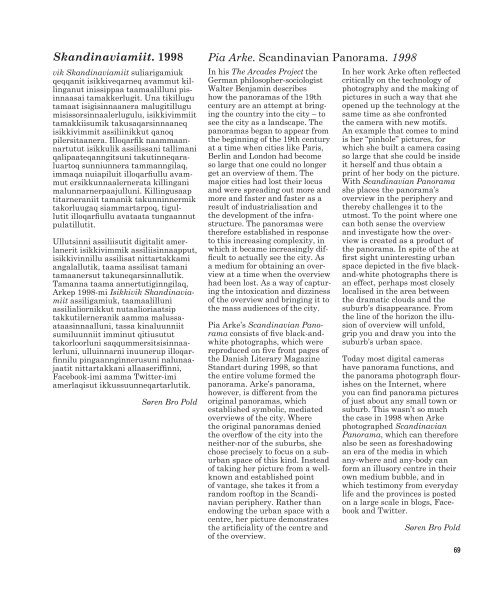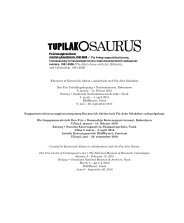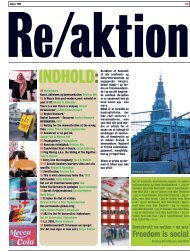tupilakosaurus - Print matters!
tupilakosaurus - Print matters!
tupilakosaurus - Print matters!
You also want an ePaper? Increase the reach of your titles
YUMPU automatically turns print PDFs into web optimized ePapers that Google loves.
Skandinaviamiit. 1998<br />
vik Skandinaviamiit suliarigamiuk<br />
qeqqanit isikkiveqarneq avammut killinganut<br />
inissippaa taamaalilluni pisinnaasai<br />
tamakkerlugit. Una tikillugu<br />
tamaat isigisinnaanera malugitillugu<br />
misissorsinnaalerlugulu, isikkivimmiit<br />
tamakkiisumik takusaqarsinnaaneq<br />
isikkivimmit assiliinikkut qanoq<br />
pilersitaanera. Illoqarfik naammaannartutut<br />
isikkulik assilissani tallimani<br />
qalipaateqanngitsuni takutinneqaraluartoq<br />
sunniunnera tammanngilaq,<br />
immaqa nuiapiluit illoqarfiullu avammut<br />
ersikkunnaalernerata killingani<br />
malunnarnerpaajulluni. Killingusaap<br />
titarneraniit tamanik takunninnermik<br />
takorluugaq siammartarpoq, tigullutit<br />
illoqarfiullu avataata tungaannut<br />
pulatillutit.<br />
Ullutsinni assiliisutit digitalit amerlanerit<br />
isikkivimmik assiliisinnaapput,<br />
isikkivinnillu assilisat nittartakkami<br />
angalallutik, taama assilisat tamani<br />
tamaanersut takuneqarsinnallutik.<br />
Tamanna taama annertutiginngilaq,<br />
Arkep 1998-mi Isikkivik Skandinaviamiit<br />
assiligamiuk, taamaalilluni<br />
assilialiornikkut nutaalioriaatsip<br />
takkutilerneranik aamma malussaataasinnaalluni,<br />
tassa kinaluunniit<br />
sumiluunniit imminut qitiusutut<br />
takorloorluni saqqummersitsisinnaalerluni,<br />
ulluinnarni inuunerup illoqarfinnilu<br />
pingaannginnerusuni nalunaajaatit<br />
nittartakkani allaaseriffinni,<br />
Facebook-imi aamma Twitter-imi<br />
amerlaqisut ikkussuunneqartarlutik.<br />
Søren Bro Pold<br />
Pia Arke. Scandinavian Panorama. 1998<br />
In his The Arcades Project the<br />
German philosopher-sociologist<br />
Walter Benjamin describes<br />
how the panoramas of the 19th<br />
century are an attempt at bringing<br />
the country into the city – to<br />
see the city as a landscape. The<br />
panoramas began to appear from<br />
the beginning of the 19th century<br />
at a time when cities like Paris,<br />
Berlin and London had become<br />
so large that one could no longer<br />
get an overview of them. The<br />
major cities had lost their locus<br />
and were spreading out more and<br />
more and faster and faster as a<br />
result of industrialisation and<br />
the development of the infrastructure.<br />
The panoramas were<br />
therefore established in response<br />
to this increasing complexity, in<br />
which it became increasingly difficult<br />
to actually see the city. As<br />
a medium for obtaining an overview<br />
at a time when the overview<br />
had been lost. As a way of capturing<br />
the intoxication and dizziness<br />
of the overview and bringing it to<br />
the mass audiences of the city.<br />
Pia Arke’s Scandinavian Panorama<br />
consists of five black-andwhite<br />
photographs, which were<br />
reproduced on five front pages of<br />
the Danish Literary Magazine<br />
Standart during 1998, so that<br />
the entire volume formed the<br />
panorama. Arke’s panorama,<br />
however, is different from the<br />
original panoramas, which<br />
established symbolic, mediated<br />
overviews of the city. Where<br />
the original panoramas denied<br />
the overflow of the city into the<br />
neither-nor of the suburbs, she<br />
chose precisely to focus on a suburban<br />
space of this kind. Instead<br />
of taking her picture from a wellknown<br />
and established point<br />
of vantage, she takes it from a<br />
random rooftop in the Scandinavian<br />
periphery. Rather than<br />
endowing the urban space with a<br />
centre, her picture demonstrates<br />
the artificiality of the centre and<br />
of the overview.<br />
In her work Arke often reflected<br />
critically on the technology of<br />
photography and the making of<br />
pictures in such a way that she<br />
opened up the technology at the<br />
same time as she confronted<br />
the camera with new motifs.<br />
An example that comes to mind<br />
is her “pinhole” pictures, for<br />
which she built a camera casing<br />
so large that she could be inside<br />
it herself and thus obtain a<br />
print of her body on the picture.<br />
With Scandinavian Panorama<br />
she places the panorama’s<br />
overview in the periphery and<br />
thereby challenges it to the<br />
utmost. To the point where one<br />
can both sense the overview<br />
and investigate how the overview<br />
is created as a product of<br />
the panorama. In spite of the at<br />
first sight uninteresting urban<br />
space depicted in the five blackand-white<br />
photographs there is<br />
an effect, perhaps most closely<br />
localised in the area between<br />
the dramatic clouds and the<br />
suburb’s disappearance. From<br />
the line of the horizon the illusion<br />
of overview will unfold,<br />
grip you and draw you into the<br />
suburb’s urban space.<br />
Today most digital cameras<br />
have panorama functions, and<br />
the panorama photograph flourishes<br />
on the Internet, where<br />
you can find panorama pictures<br />
of just about any small town or<br />
suburb. This wasn’t so much<br />
the case in 1998 when Arke<br />
photographed Scandinavian<br />
Panorama, which can therefore<br />
also be seen as foreshadowing<br />
an era of the media in which<br />
any-where and any-body can<br />
form an illusory centre in their<br />
own medium bubble, and in<br />
which testimony from everyday<br />
life and the provinces is posted<br />
on a large scale in blogs, Facebook<br />
and Twitter.<br />
Søren Bro Pold<br />
69




